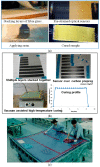Overview of Fiber Optic Sensor Technologies for Strain/Temperature Sensing Applications in Composite Materials
- PMID: 26784192
- PMCID: PMC4732132
- DOI: 10.3390/s16010099
Overview of Fiber Optic Sensor Technologies for Strain/Temperature Sensing Applications in Composite Materials
Abstract
This paper provides an overview of the different types of fiber optic sensors (FOS) that can be used with composite materials and also their compatibility with and suitability for embedding inside a composite material. An overview of the different types of FOS used for strain/temperature sensing in composite materials is presented. Recent trends, and future challenges for FOS technology for condition monitoring in smart composite materials are also discussed. This comprehensive review provides essential information for the smart materials industry in selecting of appropriate types of FOS in accordance with end-user requirements.
Keywords: composite materials; fiber optic sensor; smart materials; strain/temperature sensing; structural health monitoring.
Figures


















References
-
- Garg D.P., Zikry M.A., Anderson G.L., Gros X.E. Current and potential future research activities in adaptive structures: An ARO perspective. Smart Mater. Struct. 2001;10:610–623. doi: 10.1088/0964-1726/10/4/304. - DOI
-
- Balageas D. Structural Health Monitoring. ISTE; London, UK: 2006. Introduction to structural health monitoring; pp. 16–43.
-
- Cai J., Qiu L., Yuan S., Shi L., Liu P., Liang D. Composites and Their Applications. InTech; Rijeka, Croatia: 2012. Structural Health Monitoring for Composite Materials.
-
- Gros X.E. Current and Future Trends in Non-Destructive testing of Composite Materials. Ann. Chim. Sci. Mater. 2000;25:539–544. doi: 10.1016/S0151-9107(01)80007-6. - DOI
Publication types
LinkOut - more resources
Full Text Sources
Other Literature Sources

